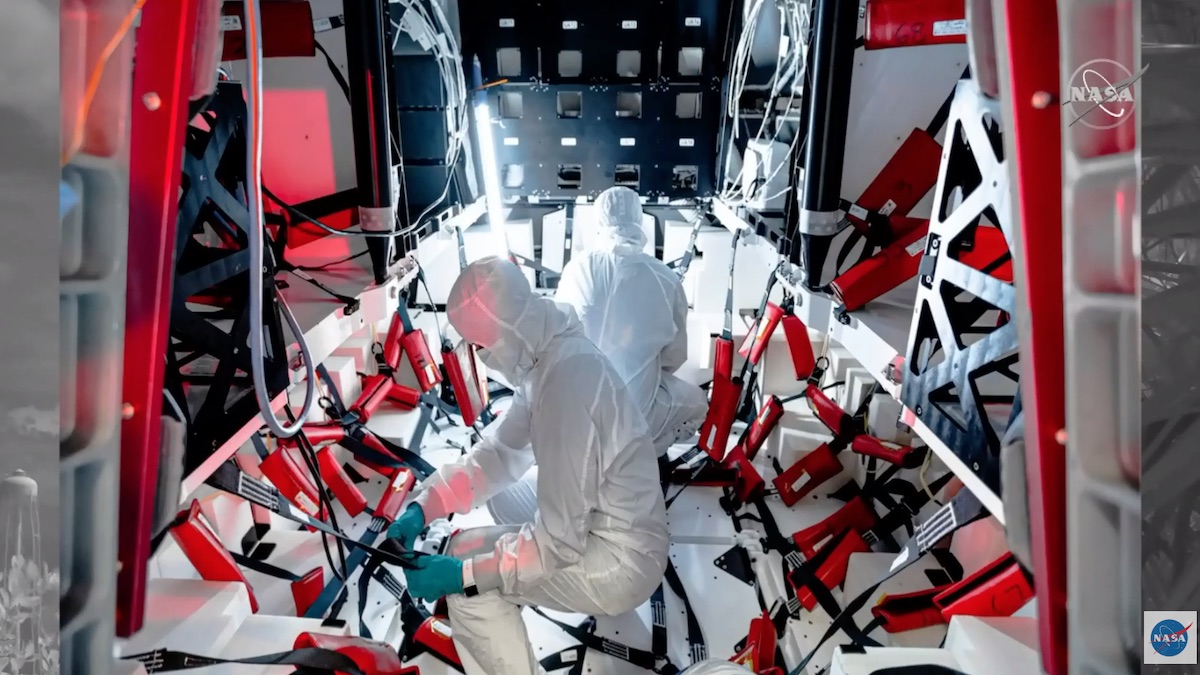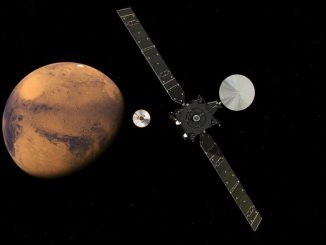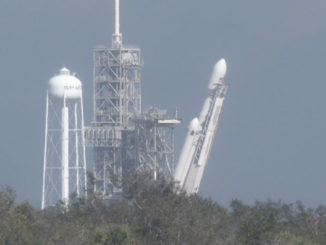
A more spacious version of SpaceX’s Dragon cargo capsule linked up with the International Space Station Monday, using a new approach corridor to deliver more than 6,000 pounds of provisions and experiments, a commercial airlock, and a holiday feast for the research lab’s seven-person crew.
Moving through the airless vacuum of space on autopilot, the Dragon cargo ship docked with the space station’s Harmony module at 1:40 p.m. EST (1840 GMT) Monday, wrapping up a 26-hour journey since the mission took off Sunday morning from pad 39A at NASA’s Kennedy Space Center in Florida.
The unpiloted supply ship fined-tuned its course toward the space station with a series of thruster firings. After initially approaching the complex from below, the Cargo Dragon performed a half-circle flyaround of the station to line up with the docking port on the zenith, or top-facing, side of the Harmony module.
Then the spacecraft moved in for docking, with data from cameras and laser sensors helping guide the Cargo Dragon to an automated docking. After contacting the docking adapter, the docking system ring retracted and hooks closed to create a firm connection between the space station and the SpaceX cargo ship.
The Cargo Dragon capsule is the first spacecraft to dock at Harmony’s zenith port. With the arrival of the new supply ship, there are two SpaceX Dragon spaceships attached to the space station for the first time.
“Dragons everywhere you look,” said Kenny Todd, NASA’s deputy space station program manager.
Besides the high-tech hardware and experiments, the Cargo Dragon delivered holiday treats including roasted turkey, spicy green beans, macaroni and cheese, cornbread dressing, cherry blueberry cobbler, and shortbread cookies.
Contact and capture confirmed.
SpaceX’s 21st Dragon cargo mission has arrived at the International Space Station with more than 6,000 pounds of supplies and experiments.
This is the first Dragon cargo flight to automatically dock with the station.https://t.co/FAMaoqlOTP pic.twitter.com/ndrcemQBlN
— Spaceflight Now (@SpaceflightNow) December 7, 2020
SpaceX’s Crew Dragon “Resilience” capsule arrived at the station Nov. 16 with astronauts Mike Hopkins, Victor Glover, Shannon Walker, and Soichi Noguchi. The Crew Dragon Resilience spacecraft is docked to the forward end of the Harmony module.
Hopkins and his crewmates joined NASA astronaut Kate Rubins and Russian cosmonauts Sergey Ryzhikov and Sergey Kud-Sverchkov on the space station, giving the research complex a long-duration crew of seven for the first time.
With so many astronauts living and working on the station, the Cargo Dragon’s arrival Monday brought more experiments and hardware to keep the crew busy. It was the 21st time a SpaceX cargo capsule delivered supplies to the station, but the latest mission marks the first flight of an upgraded Cargo Dragon capsule derived from SpaceX’s human-rated Crew Dragon.
“I would just like to say a huge congratulations to all the teams that worked on SpaceX-21,” radioed astronaut Kate Rubins from the space station. “It’s pretty amazing to think that less than a month you got four crew members to the International Space Station, and now you’re bringing a vehicle full of world-class science for us to execute.”
The Cargo Dragon docking Monday raised the space station’s mass to 996,828 pounds, or about 452 metric tons, including the two visiting Dragon vehicles, two Russian Progress supply freighters, a Soyuz crew capsule, and a Northrop Grumman Cygnus cargo ship, according to NASA. That’s a record for the space station’s mass since the retirement of NASA’s space shuttle fleet.
The station astronauts planned to open hatches leading to the Cargo Dragon and begin unpacking the capsule’s pressurized cabin. Meanwhile, the space station’s robotic arm will extract a new commercial airlock module owned by Houston-based Nanoracks for mounting on the lab’s Tranquility module.
The Cargo Dragon is scheduled to stay at the space station for more than a month until it undocks and comes back to Earth in January with several tons of research specimens and other cargo.

The cargo-dedicated variant of SpaceX’s new-generation Dragon spacecraft lacks the Crew Dragon’s launch abort system, touchscreen displays, and seats. The internal volume is instead filled with racks and freezers to hold supplies and experiments.
According to SpaceX, the new Cargo Dragon spacecraft can haul about 20 percent more cargo volume than previous Dragon supply ships, which SpaceX retired earlier this year. The new cargo vehicle can stay at the space station for up to 75 days, more than twice as long as the first-generation Dragon spacecraft, said Sarah Walker, director of Dragon mission management at SpaceX.
The Cargo Dragon can be be reused up to five times, an improvement over the three-flight design of the first-generation Dragon cargo capsule. The new spacecraft will autonomously dock with the space station. Past Dragon cargo missions had to be captured by astronauts using the space station’s Canadian robot arm.
That change reduces the workload on the space station crew and makes the Cargo Dragon’s rendezvous profile nearly identical to the Crew Dragon, but the docking port used by the new Cargo Dragon has a narrower passageway than the connection used by the berthing system on the first-generation Dragon cargo capsule.
Northrop Grumman’s Cygnus supply ship is designed to berth to the space station with the robotic arm, offering transportation for bulkier items.
The upgraded cargo capsules will splash down under parachutes in the Atlantic Ocean east of Florida, rather than the previous recovery zone in the Pacific Ocean west of Baja California.
The Dragon recovery vessels stationed at Port Canaveral, Florida, have helipads, allowing SpaceX to remove cargo and scientific specimens from the Cargo Dragon for transport to the Kennedy Space Center within hours, instead of days, said Kirt Costello, NASA’s chief scientist for the International Space Station.

“That ability to get science back quickly is so important for space biology because we want to understand whether the effects that we’re trying to measure on orbit are due to the microgravity condition or due to the stress that a participant or a sample might see on landing,” Costello said. “So having those returned to the Cape really quickly and handed over to our scientists is a great new capability.”
The Cargo Dragons, like SpaceX’s Crew Dragons, will be refurbished between missions inside a facility at Cape Canaveral Air Force Station. Splashdowns in the Atlantic Ocean shorten the travel time for the spacecraft from the recovery zone to the refurbishment site.
SpaceX says all upgraded Cargo Dragon missions will launch from pad 39A at the Kennedy Space Center, the same facility that hosts crew launches. That allows ground teams to load last-minute supplies and time-sensitive experiments into the capsule using the access arm built for astronauts.
NASA signed a new cargo delivery contract with SpaceX for at least six upgraded Cargo Dragon space station flights in 2016. A NASA spokesperson said in November that the resupply contract has been extended to cover nine Cargo Dragon missions.
The bell-shaped Bishop airlock carried aboard the Cargo Dragon will move equipment into and out of the space station, expanding on a similar capability currently provided by an airlock inside the Japanese Kibo lab module.
“About five years ago, Nanoracks identified a need for customer and market demand for a bigger airlock, and one that could be opened a little more frequently than the Kibo one,” said Brock Howe, Nanoracks project manager for the Bishop airlock.
So far, Nanoracks has signed agreements with NASA, the European Space Agency, and the Japanese robotics company GITAI to use the new airlock to dispose of trash and perform experiments. Other customers could use the airlock to deploy small satellites.
The station’s robotic arm will periodically move the airlock on and off its home on the Tranquility module. The operations plan allows astronauts to mount satellites and experiments inside the airlock before the robot arm removes it to expose the payloads to the space environment.
The Bishop airlock is about five times bigger than the Kibo airlock. The new airlock also has exterior connections to host experiments outside the space station.
“There are a lot of different environments that the scientists can use, a lot of different volumes and scientists can use, a lot of different payload power and data capabilities on-board the airlock that really will enhance their ability to do some really cool science on-board ISS,” Howe said.
Read our earlier story for more information on the Bishop airlock.
Other items on the way to the space station inside the Cargo Dragon include spares and consumables for the research lab’s new female-friendly toilet, live rodents and support hardware for biological experiments, and an upgraded catalytic reactor for the water processing system.
One experiment on the Cargo Dragon mission, named BioAsteroid, will look at how microbes might assist in mining material on asteroids.
“BioAsteroid is an experiment to study whether we can use microorganisms, bacteria or fungi, to extract economically interesting elements from asteroid material,” said Charles Cockell, professor of astrobiology at the University of Edinburgh and BioAsteroid’s principal investigator. “It’s essentially what we would call a biomining experiment, and we hope to learn whether we can use microbes to extract things like rare Earth elements and other elements that can be used to sustain a self-sustaining human presence throughout the solar system.”
The BioAsteroid experiment follows a similar investigation named BioRock, which demonstrated how microbes could extract valuable metals from basalt rock, a material that covers the moon and Mars. Now scientists want to study if a similar biomining setup could be used on asteroids.
Other payloads on the Cargo Dragon mission will help scientists learn more about how spaceflight affects cardiovascular cells and human brain organoids, yielding insights into how microgravity impacts the survival and metabolism of brain cells.
Here is a breakdown of the Dragon supply ship’s cargo load:
- Nanoracks Bishop Airlock: 2,403 pounds (1,090 kilograms)
- Science Investigations: 2,100 pounds (953 kilograms)
- Crew Supplies: 803 pounds (364 kilograms)
- Vehicle Hardware: 698 pounds (317 kilograms)
- Spacewalk Equipment: 265 pounds (120 kilograms)
- Computer Resources: 102 pounds (46 kilograms)
- Russian Hardware: 53 pounds (24 kilograms)
Email the author.
Follow Stephen Clark on Twitter: @StephenClark1.



